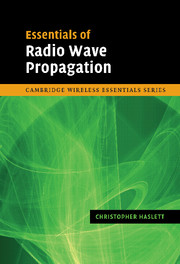Book contents
- Frontmatter
- Contents
- Preface
- Acknowledgements
- 1 Propagation in free space and the aperture antenna
- 2 Point-to-area transmission
- 3 The effect of obstacles
- 4 Reflection, scatter and penetration
- 5 Estimating the received signal strength in complex environments
- 6 Atmospheric effects
- 7 System design and interference management
- 8 Software-based tools
- 9 Summary
- Appendix 1 The decibel scale
- Appendix 2 Phasor arithmetic and phasor diagrams
- Appendix 3 Formula sheet
- Appendix 4 Explanation of the link budget
- Further reading
- References
- Recommendations of the Radiocommunication Bureau of the International Telecommunications Union (ITU), Geneva
- Author's biography
- Index
5 - Estimating the received signal strength in complex environments
Published online by Cambridge University Press: 09 August 2009
- Frontmatter
- Contents
- Preface
- Acknowledgements
- 1 Propagation in free space and the aperture antenna
- 2 Point-to-area transmission
- 3 The effect of obstacles
- 4 Reflection, scatter and penetration
- 5 Estimating the received signal strength in complex environments
- 6 Atmospheric effects
- 7 System design and interference management
- 8 Software-based tools
- 9 Summary
- Appendix 1 The decibel scale
- Appendix 2 Phasor arithmetic and phasor diagrams
- Appendix 3 Formula sheet
- Appendix 4 Explanation of the link budget
- Further reading
- References
- Recommendations of the Radiocommunication Bureau of the International Telecommunications Union (ITU), Geneva
- Author's biography
- Index
Summary
A radio wave can often travel from a transmitter to a particular point by a number of routes: directly, by diffraction, by reflection, by penetration. At any point, the power received by a receiving antenna will be a combination of all these propagation mechanisms. Because the combined signal is a phasor sum of all the individual contributions an accurate prediction of the electric field strength is very difficult to obtain: it would need knowledge of the distance travelled for each propagation mechanism to within about a tenth of a wavelength plus details of the electrical properties of any materials involved in the paths involving reflection or penetration. Usually, all that is practical is to estimate the strength of the signal that would be achieved by each propagation path in isolation. The total received power is then estimated as the sum of these individual contributions. This gives an estimate of what is called the ‘local-mean’ level. That means that the actual power received would vary about this level by an amount that depends upon the relative strengths and directions of the individual contributions. If the angular separation of the individual contributions, when viewed from the receiver, is small then the signal will not vary very quickly with distance. Further, if one of the contributions is dominant and provides the majority of the signal power on its own then the variation will not be as great as if all the different propagation paths contributed nearly equal amounts of power.
- Type
- Chapter
- Information
- Essentials of Radio Wave Propagation , pp. 110 - 115Publisher: Cambridge University PressPrint publication year: 2007
- 1
- Cited by



